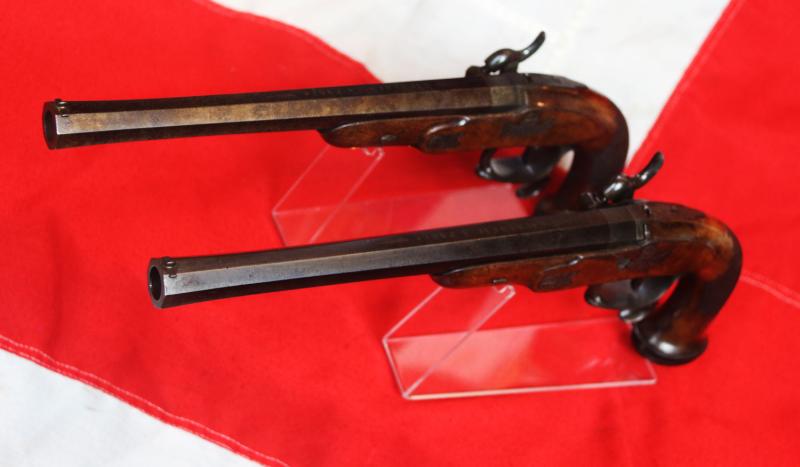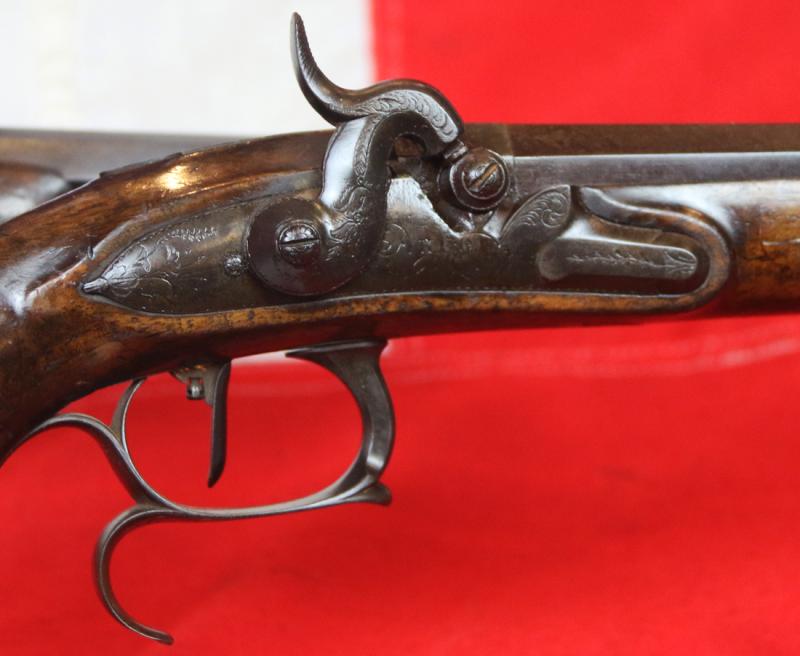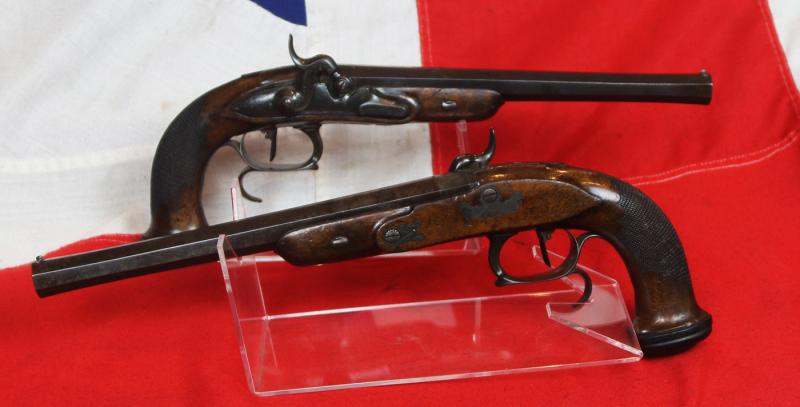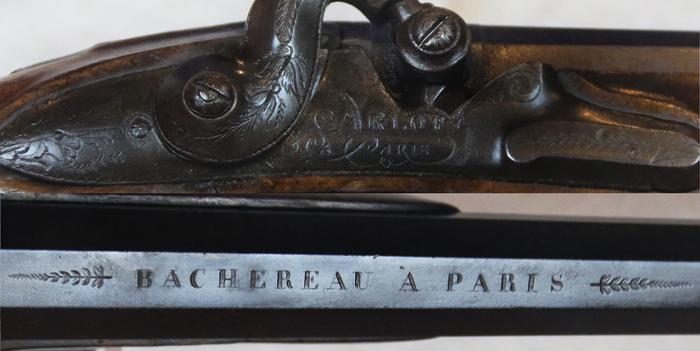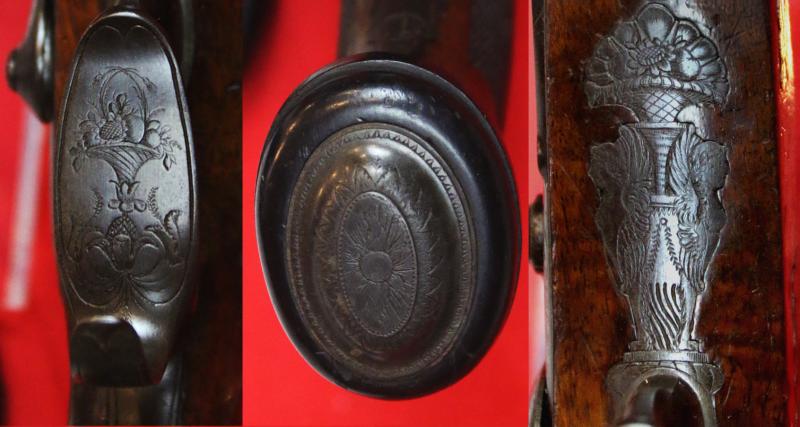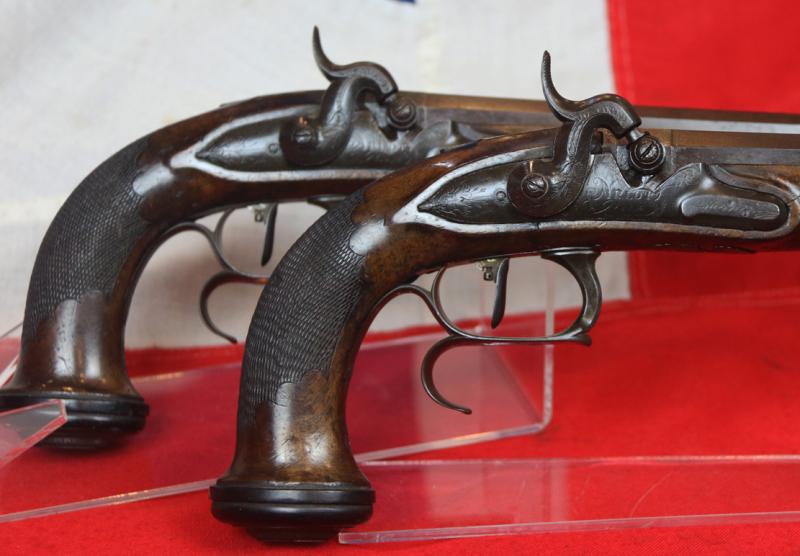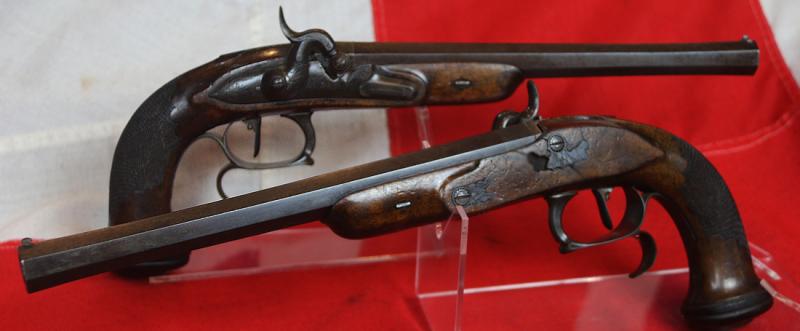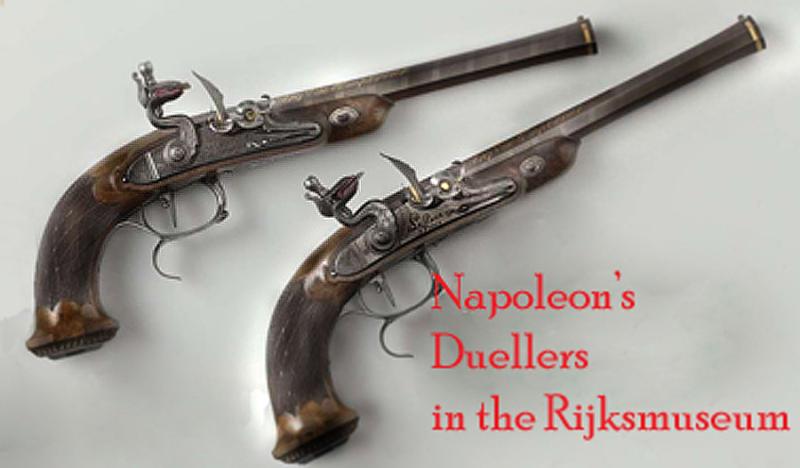A Very Fine Pair of Absolutely Beautiful French, Napoleonic 1st Empire Period, Circa 1804, Duelling Pistols, by Arlot of Paris, Near Identical To Napoleon's Pair of Duelling Pistols Taken at Waterloo
Made circa 1804 by master gunsmith and maker to the King of France, Jean Arlot of Paris. Jean Arlot was a very fine gunmaker, based in Paris [c.1780-1815] and was the Royal gunmaker to King Louis XVI, prior to the French Revolution. These wonderful pistols were made in the period when Napoleon declared himself Emperor of all France, known as the 1st French Empire Period. There is a most similar beautiful pair of French duellers in the Rijksmuseum in Holland [see them in our photo gallery for comparison] that belonged to Napoleon Bonaparte, those pistols came into the possession of Lieutenant Henry Sagermans of Brussels shortly after the Battle of Waterloo. Sagermans claimed the pistols were found in Napoleon's travel carriage which had been abandoned near the battlefield. This French Empire period pair of pistols were originally crafted in the late flintlock period and then expertly converted to percussion, including careful engraving the hammer in order to match the original lock’s engraving which are signed "ARLOT" at the centres. The swamped barrels have fine "micro-groove" style rifling, a dovetailed blade front sight, engraved Bachereau "A PARIS", a sighting groove that extends onto the breech plug, and a notch rear sight within the groove. They are also equipped with adjustable single set triggers, very finely engraved furniture, spurred trigger guards, and a chequered and carved half-stocks. Fine with 85% plus blue finish light case colours, crisp engraving, grey and brown patina on the balance, and general light age and storage related wear. Aside from a single hairline crack the stocks are superb, and they have crisp carving and micro chequering with light wear commensurate for age.
Napoleon gifted allies and personal friends with splendid weapons from the Versailles Arms Factory, very similar to this stunning pair. Such presents could be expensive even for luxury goods: King Charles IV of Spain, an ally of France and a dedicated huntsman, received a set of nine guns, also a pair of duelling pistols which cost 130,000 francs (which was the equivalent of 36,000 days of wages for a skilled tradesman in those days, thus approx 12 years pay).
Napoleon and the art of honouring loyalty and bravery
In France, it was customary for the King to award weapons of honour for exceptional service. Awarding royal military honours was stopped with the abolition of the monarchy in 1792, but reinstated a couple of years later by Napoleon, then Commander-in-chief.
Napoleon first awarded arms of honour for individual acts of bravery during the Italian campaign of 1796-1797, and he decided to increase doing so in an order from 28 August 1797. The distribution of weapons of honour was made official by the Consulate in an order from 25. December. Napoleon regulated which ranks received what kind of arms: officers received pistols, grenadiers and the line infantry received rifles or sabres, and the cavalry troops received rifles, too.
The gifts Napoleon made to military heroes and statesmen were also admired by the British. While usually not being present with them, they bought or took them from Napoleon’s fallen allies that were defeated in the war or went into exile. The 1st Marquess Wellesley, Brother to Arthur Wellesley, presented George, The Prince of Wales, in May 1810 with a pair of flintlock rifled pistols. Its barrel was inlaid with gold ornaments. It is part of the Royal Collection Trust
practices and rituals were codified in the Code Duello of 1777 which set forth rules describing all aspects of an "affair of honour," from the time of day during which challenges could be received to the number of shots or wounds required for satisfaction of honour. For gentlemen the law "offered no redress for insults" he might be subject to from rivals and enemies. Shooting a fellow officer in a duel "gave a sharp edge to one's reputation, earned congratulations in the regimental mess, and brought admiring glances from the ladies. Higher military authorities regarded duelling as a proof test of courage" Although theoretically banned by British Army regulations, refusing a challenge was likely to result in an officer having to leave his regiment, for the same rules that banned duelling forbade an officer from submitting to "opprobrious expressions" or "any conduct from another that should degrade him, or, in the smallest way impeach his courage." To decline a challenge was often equated to defeat by forfeiture, and was sometimes even regarded as dishonourable. Prominent and famous individuals ran an especial risk of being challenged for duels.
Among the most famous duels are the American Burr-Hamilton duel, in which notable Federalist Alexander Hamilton was fatally wounded, and the duel between Duke of Wellington and the 10th Earl of Winchilsea, wherein each participant intentionally missed the other. In New Orleans in 1817 wealthy Creole Bernard de Marigny challenged American blacksmith James Humble to a duel. Humble at nearly seven feet tall had the advantage of size but had never so much as handled a weapon before, and Marigny was only five-nine but a deadly fighter. But by tradition, Humble, as the challenged party, had choice of weapons and location. His choice: the duel would be fought with blacksmith hammers standing in six feet of water in Lake Pontchartrain. Marigny immediately declared that he could not possibly harm a man with such a sense of humour and invited Humble home for dinner. Some were fought over matters of great import, such as Whig leader George Tierney's challenge to William Pitt, after the prime minister accused him of a lack of patriotism; while at the other extreme, in 1721, two Irishmen fought over the correct spelling of a Greek word. Natchez, Mississippi: September 20, 1827: Formidable frontier knife fighter Jim Bowie was shot twice, stabbed "many" times, and had a sword impaled in his chest but still managed to stand, fight, and kill in a gentlemen's duel gone dreadfully wrong.
Since duelling is illegal in Mississippi, it all happened on a sandbar on the Louisiana side of the Mississippi River just west of here, yesterday. Samuel Wells of Natchez faced Louisiana doctor Thomas Maddox in a pistol duel. Each man had a large contingency of witnesses. Both men were allowed two shots at each other. Both missed. So, the actual duel ended with a laugh, with a handshake and with the opening of a bottle of wine, celebrating the duellers new found friendship.
Bowie was Wells second in the duel, and Judge R.A. Crane from Louisiana was Dr. Maddox's second.
As the wine flowed so, suddenly, did the anger, not between the duellists but between the two seconds, Jim Bowie and Judge Crane.
Crane pulled a pistol and fired twice. A bullet punctured Bowie's thigh. He went down. The second bullet hit Bowie's friend Dr. Samuel Cuney, who was there just to witness the duel. He slumped to his knees, then toppled face first to the sand? dead.
Brawling bloody bedlam began. Friends of each dueler became mortal enemies. Bullets whined through gun smoke, and knife blades slashed in the sun.
Major Norris Wright, a banker from Alexandria who hated Jim Bowie and had tried to kill him before, took the opportunity to unsheathe his cane sword and impale Bowie in the chest as Bowie lay wounded on the ground. With the sword still sticking in his chest, Bowie grabbed Wright's coattails and pulled Wright toward him on the ground, slashing Wright's mid-section back and forth with his big, curved knife, killing him instantly.
Witnesses say Bowie then stood up with the sword wobbling in his chest, a bullet in his thigh, and a knife wound gaping in his side, as attackers continued to stab him and shoot at him.
When the attacks stopped, either through fear or fatigue, two men lay dead; two more men tried to patch serious wounds; and the others wiped blood with torn shirts from their grazes and gashes.
As smoke cleared, the dead and wounded were taken by boat across the river to Natchez for civilised burial and modern medical treatment. Sometimes, however, duels were fought for political reasons. In 1798, the Prime Minister of England, William Pitt, accused George Tierney, an opposition politician, of desiring to obstruct the defence of England. Tierney demanded that Pitt withdraw the accusation; Pitt refused. Tierney challenged him to a duel, and the two met near London. The first set of shots went wild, and Pitt fired his second shot into the air, thereby vindicating honour. As with all our antique guns no license is required as they are all unrestricted antique collectables 1cm of one sideplate lacking to one reverse side of one pistol. Mechanically, both pistols are very fine indeed, of top quality craftsmanship, with fine crisp actions. 245mm barrels, overall 370mm long
Code: 22574
7995.00 GBP


